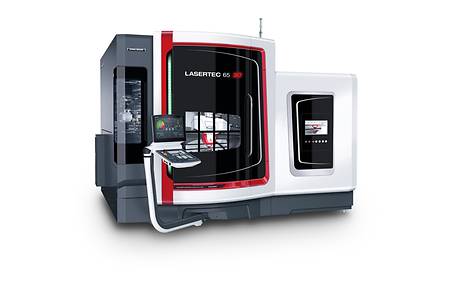Generative manufacture of 3D components in finished part quality
DMG MORI will be presenting its LASERTEC 65 3D, a hybrid machine that is currently unique on the market which incorporates generative laser deposition welding into a fully-fledged 5-axis milling machine.
In times of ever shorter product life cycles and increasingly more complex and more individualised components, generative manufacturing processes can help companies to produce new and innovative products more quickly. Generative manufacturing processes enable the production of complex geometries and workpieces. The unique technology combination of laser deposition welding by means of a powder nozzle and milling gives the user completely new application and geometry options. With the LASERTEC 65 3D DMG MORI now offers a hybrid solution for combined laser deposition welding and 5-axis milling. This process uses a deposition process by means of a powder nozzle, which is up to 10 times faster than generation in a powder bed.
The market for additive processes has grown rapidly in the past. However, up to now these processes have been restricted to the production of prototypes and small parts, which could not otherwise have been manufactured using conventional methods. With the combination of the two processes, metal deposition and metal removal, on one machine additive technology complements and enhances traditional machining methods.
To enable generative manufacturing, the LASERTEC 65 3D is equipped with a 2-kW diode laser for laser deposition welding, while the fully fledged 5-axis milling machine in robust monoBLOCK design also makes it possible to carry out highly accurate milling operations. “Thanks to the fully automatic changeover between milling and laser operation, the LASERTEC 65 3D is suitable for the complete machining of complex components with undercuts as well as for repair work and the application of partial or complete coatings for mould making and mechanical engineering or even medical engineering”, explains Friedemann Lell, Sales Director Sales Director for LASERTEC at SAUER GmbH.
Producing large parts generatively
In contrast to laser melting in a powder bed, laser deposition welding enables large parts to be manufactured using a metal powder nozzle. With a deposition rate of up to 1 kg/h, this process is up to 10 times faster than the laser generation of parts in a powder bed. The combination with milling opens up completely new applications. The component can be built up in several steps, whereby milling can be interspersed with deposition welding in order to allow areas, which the cutter would no longer be able to reach when the component was finished due to the component geometry, to be machined to final accuracy.
The hybrid machine combines the advantages of milling, such as high precision and surface quality, with the flexibility and high deposition rate of powder deposition welding. “In the case of integral components, where today 95 % of the material is removed by milling, with additive processes material is only built up where it is needed. This leads to significant savings in raw materials and costs”, explains Lell.
The laser, complete with powder deposition head, is fitted into the HSK toolholder of the milling spindle. It can be automatically parked in a secure docking station while milling operations are being carried out on the machine. The machine and process are operated and controlled by means of the new 21.5” ERGOline control with CELOS and Operate 4.5 on SIEMENS 840D solutionline.
Production of 3D contours
Using a laser diode the metal powder is deposited in layers onto a base material and fuses with this without pores or cracks. The metal powder forms a high-strength welded bond with the surface. A coaxial inert gas prevents oxidation during the build-up process. After cooling a layer of metal forms which can be machined mechanically.
As laser deposition welding has long been established as a stand-alone technology, it is ideal for incorporation into DMG MORI’s high-quality CNC machines. “The combination of chip-removal and additive processes will become more important in future, as it opens up so many new options and advantages for the user”, says Lell.
One strength of this process is the option to successively build up layers of different materials in lines of 1.6 mm and 3 mm are possible depending on the nozzle geometry. Even complex 3D contours can be generated with any supporting geometry.
The individual layers can then be accurately machined before the areas become inaccessible to a cutter or other tools due to the component geometry. The combination of the two processes is a sensible choice for repair work and the production of tools and moulds. However, it also offers many interesting options for lightweight components, prototypes or small series production – particularly in the large-part manufacturing sector where other additive manufacturing processes cannot be used due to limited space.
Economical solution
Large machines, such as those used for machining bulky components in the energy or aerospace industries, tend to be expensive. So the possibility of carrying out roughing, deposition and finishing on a single machine therefore represents a financially advantageous solution for the customer. Another example here is the energy and oil industry where components often have to be coated with corrosion-resistant alloys to protect them against wear. Deposition welding provides protection for products such as pipes, fittings, flanges and special constructions which are used in aggressive environments. With a hybrid solution, machining of the base material, coating and finishing can be carried out on one machine. This results in cost savings and a reduction in throughput times.
Highlights – LASERTEC 65 3D
- Intelligent combination of laser deposition and milling enables maximum surface finish and component precision
- Laser deposition welding with powder nozzle: up to 10 x faster than powder bed processes
- Feasibility of complete 3D components with diameters up to 500 mm without any supporting geometry, even with overhanging contours
- Direct machining of areas that are no longer accessible on the finished part
